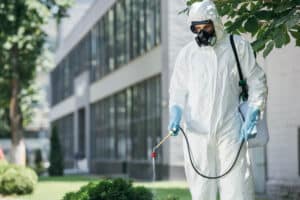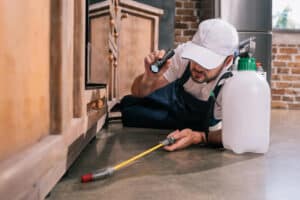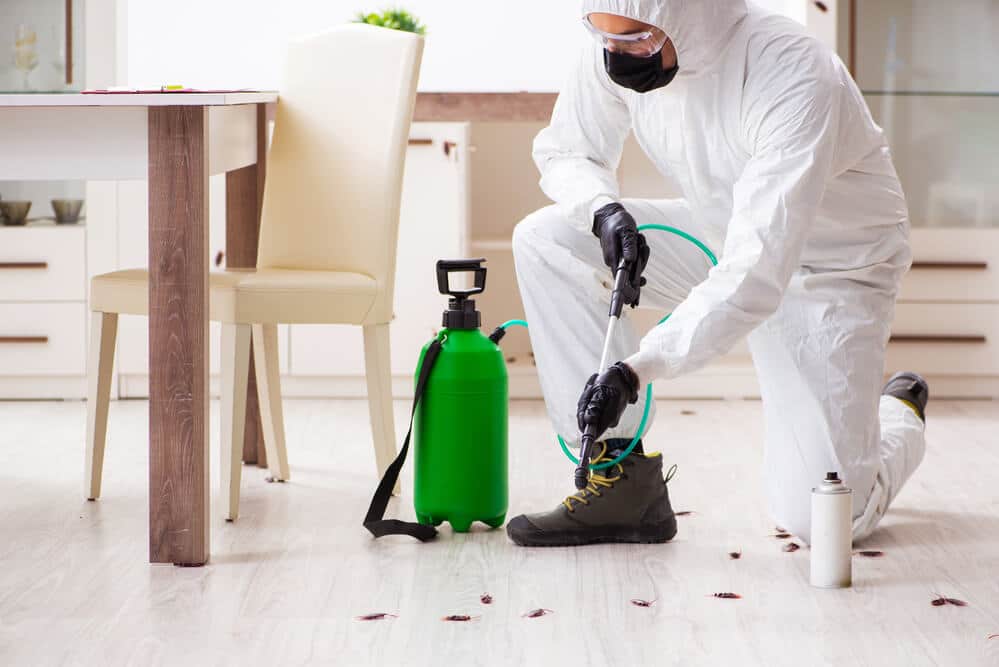Purchasing a home is a monumental milestone, especially for those seeking the support of VA loans to realize their dreams. In the intricate landscape of home financing, one often overlooked but absolutely critical facet is pest inspections.
These inspections aren’t merely an additional formality; they serve as guardians of both property value and the borrower’s investment.
Imagine finding the perfect home—spacious, cozy, and seemingly flawless. Yet, lurking beneath the surface, invisible invaders like termites and other pests could be silently wreaking havoc on the property’s structural integrity.
Here is where pest inspections step into the spotlight. Their role extends far beyond assessing the condition of wooden beams and foundations; they act as a safeguard against hidden damage that could tarnish the investment.
Amid this backdrop of safeguarding investments and securing properties, the connection between pest inspections and VA loans becomes evident. The U.S. Department of Veterans Affairs (VA) stipulates the necessity of pest inspections to ensure that homes financed through VA loans meet stringent quality standards.
This requirement underscores the VA’s commitment to safeguarding veterans interests, ensuring that the homes they purchase are free from the pernicious effects of wood-destroying insects and pests.
What Are Pest Inspections for VA Loans?
Despite the misleading name, pest inspections cover more than just termites. These assessments examine a property’s susceptibility to a variety of wood-destroying insects and pests in great detail.
While termites are undeniably a significant concern, inspections also consider other culprits such as carpenter ants, powder post beetles, and wood-boring bees. By encompassing this broader spectrum, pest inspections ensure that the home is fortified against all potential threats.
Termites and VA Loans
Termites, those seemingly inconspicuous insects, wield the power to dismantle even the sturdiest of structures over time. Their voracious appetite for wood poses a serious threat to a property’s structural integrity.
In the context of VA loans, termite inspections are more than a routine checkbox; they serve as a line of defense against infestations that could erode the value of the property. These inspections don’t just protect the home; they protect the veteran’s investment and provide peace of mind.
Pest Inspections
Pest inspections are crucial for a full understanding of a property’s overall condition. They do more than just identify insect infestations; they provide a complete assessment of the property’s health, pointing out weak spots.
These inspections enable homebuyers to make knowledge-based decisions and help lenders ensure the property’s value, a critical factor in granting a VA loan.
VA Loan Termite Inspection Requirements
 VA loans mandate termite inspections. This requirement, set by the U.S. Department of Veterans Affairs (VA), is more than a mere formality – it’s a crucial step in the VA loan process designed to protect veterans’ interests.
VA loans mandate termite inspections. This requirement, set by the U.S. Department of Veterans Affairs (VA), is more than a mere formality – it’s a crucial step in the VA loan process designed to protect veterans’ interests.
The goal is to ensure that the properties they invest in are not compromised by wood-destroying insects. Hence, termite inspections, which serve to uphold safety, quality, and durability standards, are a non-negotiable part of acquiring a VA loan.
Section 2 Termite Clearance on the Loan Process
Section 2 termite clearance holds the power to shape the trajectory of the VA loan process. If issues identified in this section are left unaddressed, they can compromise the property’s condition and, by extension, the loan’s security.
When a property receives Section 2 clearance, it essentially means that the identified issues have been rectified, and the property is now fortified against potential termite threats.
This clearance serves as a crucial signal to lenders that the property meets the necessary standards for a VA loan, fostering the lender’s confidence in the investment’s long-term viability.
Varying State Requirements for Pest Inspections
While the VA requires termite inspections for all VA loans, the specifics can vary depending on the state. Some states have elevated levels of termite activity, necessitating more comprehensive inspections and possibly treatment. As a result, VA loan termite inspection requirements might align with the pest prevalence in each state, ensuring that homes are adequately protected against regional threats.
It’s crucial for borrowers to be aware of their state’s unique regulations, as these variations could impact the extent of inspections required, the documentation needed, and potential remedies for identified issues.
Consulting with local experts and inspectors well-versed in state-specific regulations can help borrowers navigate this aspect of the VA loan process effectively.
Safeguarding Homes and Borrowers Through Pest Inspections
The necessity of termite inspections transcends paperwork; it’s about safeguarding the investment and well-being of both the property and the borrower. Termite damage can be insidious, working silently beneath surfaces to compromise a property’s structural integrity over time.
By requiring termite inspections, the VA ensures that these destructive forces are identified and addressed before they can wreak havoc.
Moreover, these inspections offer an additional layer of security for borrowers. By providing a thorough assessment of a property’s condition, termite inspections equip borrowers with the knowledge needed to make informed decisions.
A comprehensive inspection report empowers borrowers to negotiate potential repairs with sellers and provides lenders with assurance that the property maintains its value and integrity.
Process of Pest Inspection and Uncovering the Invisible Threats
Pest inspections are an essential part of maintaining a property, designed to uncover potential vulnerabilities. This begins with a thorough examination of both the interior and exterior, focusing on the foundation, walls, roof, and any other points where pests may enter.
Inspectors also investigate crawl spaces and attics to identify any signs of infestation or damage. By using modern tools and techniques, they can uncover threats that are not easily visible. This procedure is an important proactive measure to protect the property from potential damage.
Step By Step Process
1. Commencement of Examination
The pest inspection process begins with a meticulous evaluation of both the interior and exterior of the property. This ensures that no part of the structure remains unchecked.
2. Thorough Foundation Scrutiny
Inspectors focus on the property’s foundation, carefully examining it for any signs of existing or potential pest-related issues. This foundational assessment is crucial, as pests often target vulnerable entry points.
3. Scanning Exterior Walls
The inspection extends to the exterior walls, where inspectors closely examine surfaces for indicators of wood-destroying insects. These pests can infiltrate the property from outside, necessitating a thorough review.
4. Roof Inspection
The roof is not exempt from scrutiny. Inspectors evaluate the roof for signs of damage, openings, or areas susceptible to pest intrusion. Such weaknesses could be exploited by insects seeking shelter.
5. Assessment of Potential Entry Points
Other potential entry points, such as gaps around windows, doors, and utility openings, are meticulously assessed. These openings can serve as gateways for pests to enter the property.
6. Identification of Infestation Signs
During the inspection, inspectors are trained to recognize telltale signs of infestations, including discarded wings, fecal matter, and visible insects. These signs indicate an active pest presence.
7. Conditions Conducive to Pests
The inspection also considers conditions that might attract or sustain pests, such as moisture accumulation, wood-to-soil contact, and inadequate ventilation. These factors can make the property more susceptible to infestations.
8. Exploration of Crawl Spaces and Attics
Inspectors venture into crawl spaces and attics, often overlooked areas where pests can thrive. These spaces provide insights into potential infestations and vulnerabilities.
9. Employment of Specialized Tools
State-of-the-art tools and techniques are used to delve into the property’s hidden nooks and crannies. These tools aid in uncovering issues that might not be visible to the unaided eye.
10. Uncovering Hidden Threats
The culmination of each step aims to unveil potential threats that could compromise the property’s structural integrity. This process acts as a proactive measure to protect the property from hidden dangers.
Inspector’s Role: Assessing the Property for Wood-Destroying Insects
The pest inspector is crucial in identifying hidden infestations. Using their specialized expertise, they detect signs of pests, like wood damage and evidence of insects.
They distinguish common damage from pest-induced harm, assess conditions attracting pests, and identify preventive steps to protect the property. This evaluation helps uncover current issues and fortify the property against future invasions.
Components Included in a Pest Inspection Report
The pest inspection report marks the end of the inspection process, detailing the inspector’s findings about the property’s pest situation. It notes existing infestations, damage, and possible risks, and might suggest remediation or prevention steps.
This report is a key tool for homebuyers, sellers, and lenders. Buyers can use it to make informed decisions, sellers can tackle problems early, and lenders can assess the property’s condition and potential financial risks from pest damage.
Who Pays for Termite Inspections VA Loans?
Who pays for the termite inspection on VA loans? Typically, it’s the buyer. This cost is often seen as part of their responsibility to ensure the property meets their standards. However, who pays can change based on market conditions, and buyer and seller agreements.
Open and clear communication between both parties is key to settling this issue. If the inspection report reveals problems, it may spark negotiations on who covers remediation costs. The report guides these discussions, helping to achieve fair financial agreements that maintain the property’s value and condition.
Pest Inspections on VA Loan Refinancing
 When it comes to VA loan refinancing, the question of whether termite inspections are required often arises. The answer hinges on the specific circumstances and the type of refinancing being pursued.
When it comes to VA loan refinancing, the question of whether termite inspections are required often arises. The answer hinges on the specific circumstances and the type of refinancing being pursued.
In many cases, a termite inspection might not be mandated during a standard VA loan Interest Rate Reduction Refinance Loan (IRRRL) process, given that this type of refinancing aims to reduce interest rates without altering the property’s value.
Scenarios Triggering Termite Inspections in Refinancing
However, there are scenarios where termite inspections might indeed be required during refinancing. If the refinancing involves a cash-out refinance—where the homeowner receives cash against the property’s equity—the VA might impose the same standards as a new purchase.
This could include a termite inspection to ensure the property’s value remains intact despite the change in financing.
Another scenario is when the property itself has undergone substantial alterations or additions since the initial loan. In such cases, the VA might require a termite inspection to assess the property’s current condition and safeguard against any pest-related issues that could have emerged due to the changes.
Upholding the Property’s Condition Obligation During Refinancing
During VA loan refinancing, borrowers must remember that their obligation to maintain the property’s condition doesn’t waver. Even as the loan terms shift, the responsibility to ensure the property remains free from damage caused by pests and wood-destroying insects persists.
While a termite inspection might not be mandated for every refinancing scenario, borrowers must proactively address any pest-related concerns that might compromise the property’s value or integrity.
It’s crucial for borrowers to approach refinancing with the same level of diligence and commitment to property maintenance as they did during the initial purchase.
The property’s condition contributes not only to its value but also to the borrower’s long-term financial security. By adhering to this obligation, borrowers can navigate refinancing with confidence, knowing that their investment remains protected.
Final Thoughts
The interplay between pest inspections and VA loans is not a mere formality; it’s a guardian of investments and homes. As we’ve discovered, these inspections stand as a testament to the VA’s dedication to providing veterans with properties that are resilient against hidden threats.
Beyond safeguarding property value, pest inspections offer peace of mind—a tangible assurance that the investment made is rooted in security.
In the dynamic landscape of real estate, borrowers hold the reins of their investment’s fate. The significance of thorough pest inspections cannot be emphasized enough.
By proactively addressing potential issues and rectifying them, borrowers uphold their responsibility to protect their investment and meet the stringent requirements set by the VA. Beyond compliance, this commitment ensures the property’s longevity, its value, and the well-being of those who call it home.
Veterans and borrowers need to appreciate the importance of pest inspections in the homeownership journey. This knowledge not only aids in understanding the inspection process but also its vital role in securing loans. In essence, these insights are crucial to realizing homeownership dreams and safeguarding valued investments.
Don’t leave your dream home and investment to chance. At Sprint Funding, we understand the crucial role that pest inspections play in safeguarding your VA loan. Trust us to guide you through the process, ensuring your home remains a haven, free from hidden threats.
Secure your investment’s longevity with Sprint Funding. Contact us today to learn more about pest inspections for VA loans and realize your dream of homeownership with confidence and peace of mind.





